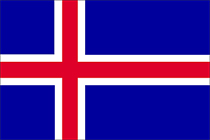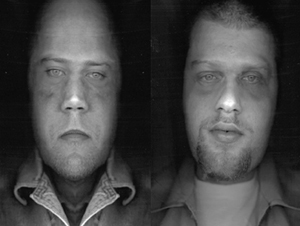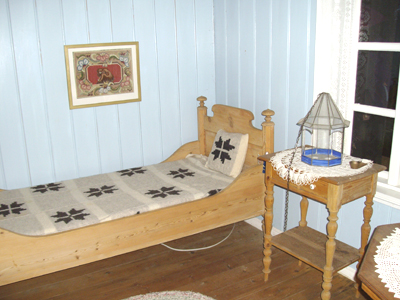 Based On a Dream exhibition images essay by Cliff Eyland Hannes Larusson Icelandic farm restoration project website The Order of the Carrot Hannes Larusson first page  This is a short overview Hannes Lárusson's career: he is a Reykjavík-based artist who studied at the Icelandic College of Arts and Crafts, the Vancouver School of Art (now the Emily Carr Institute), Universita Degli Studi Di Firenze in Italy, the Whitney Museum Independent Study Program in New York, the University of Iceland (B.A. in Philosophy), the Nova Scotia College of Art and Design (Master of Fine Arts) and Iceland's University of Education (Pedagogy). He had his first solo show in 1977 in Iceland and held his first performance work in Vancouver the same year. Since then he has produced over 75 exhibitions and/or performances in Iceland, Canada, Denmark, Finland, France, Germany, Ireland, the Netherlands, Norway, Poland, Sweden, Switzerland and the United States. Lárusson also writes, and gives critiques, lectures and speeches. He insists that there is a unifying feature that connects his performance art to his recent large restoration work on an Icelandic farmhouse. All of it is part of a continuing investigation into the relationship between contemporary visual art and Icelandic ethnic heritage. As Lethbridge artist and professor James Graham put it, “Hannes is both a traditionalist and master satirist; an Icelander deeply proud of his culture yet sharply critical of its membership.” Recently Mr. Lárusson worked with the University of Manitoba's Icelandic Department Chair Dr. Birna Bjarnadóttir as well as the local Icelandic Consul to realize several curatorial projects about Icelandic art in Winnipeg and Gimli, Manitoba. These events and shows involved the artists Ásmundur Ásmundsson, Hekla Dögg Jónsdóttir and Jón Óskar, Haraldur Jónsson and Steingrimur Eyfjörd, Gunnhildur Hauksdóttir and Kristin Omarsdóttir. Manitoba has many people of Icelandic descent and the only university Icelandic Department outside of Iceland, hence the growing cultural exchange between Icelandic and Winnipeg artists. Manitoba's connection with Iceland is strong and historically deep, beginning with the “New Icelanders” who immigrated to Gimli, Manitoba in 1875. Icelandic culture, however attenuated, has become an undercurrent of Winnipeg contemporary art. It helps that, because they learn about Gimli in grade school, Icelandic artists want to come to Manitoba. Lárusson's Based on a Dream  Hannes Lárusson's Arch 2 Gallery show consisted of large photographs of Icelandic flag-coloured (red and blue) fabric photographed in various configurations on the gallery floor; an Icelandic-flag-coloured costume that Lárusson stumbled around in half-blind during an opening performance; and a video projection of the artist balancing a log on his face. The artist left a videotape of his performance that played in the gallery for the duration of the exhibition, and the artist's costume was also left on the floor for the duration of the show. In the year 2000 I reviewed an exhibition in Halifax curated by Sue Gibson Garvey called Bedrock: six contemporary artists from Iceland.1 The show's emphasis was on geography and ethnicity in contemporary Icelandic art.  Looking back now I see Jón Óskar's Copied Mug, Distorted Mug as a precursor, at least for me, of Hannes's Arch 2 exhibition. A delightful pseudoscience was at work in Óskar's flat-bed computer scanned faces, one that spoke to the science of genetics in a parody of physiognomy. His work, which requires that a face be placed flat on a flat-bed scanner, recalls Francis Galton's obsessive 19th Century search for such chimeras as the "criminal" face. The technique also produces monstrous, Zombie-like faces. Hannes Lárusson's performance at Arch 2 Gallery looked to me like an anthropomorphized Icelandic flag, a kind of flag Zombie.2 The Norse trickster god Loki also came to mind. In any case, Lárusson had created a bizarre persona, a mute monster. Marina Warner, in Fantastic Metamorphoses, Other Worlds, cites the philosopher Simon Blackburn on Zombies: “…the Zombie eerily duplicates human behavior, only has no ghost within. Blackburn adduces zombies in a very contemporary way, to press against complacent assumptions about personhood.” 3 I'd assert that the “personhood” Lárusson presses against in his flag zombie is the clichés of Icelandic identity as summed up in the national flag. Could we see Lárusson's Zombie as a caricature of the blank, seemingly humorless composure of Northern white people like the Norse, the English, the Finns, the Scots and (some) Winnipeggers? Just as Lárusson's flag person aimlessly stumbled around staring at gallery patrons blankly, we imagine as a metaphor the entire world economy, with Iceland at its centre, walking blindly into catastrophe. Here is Marina Warner again, this time on Dante, a reference that will limit and define the Zombie for both the frozen Norse and the perma-frosted Winnipegger: There are forerunners of the zombie in medieval literature [says Warner]. Dante, for example, meets in the frozen depths of Cocytus the shade of Fra Alberigo, who explains that traitors like him can predecease their bodies, and fall into the lowest circle of hell to start their eternity of torments - eyes sealed shut by the ice, wholly entombed in permafrost, a kind of cryogenisis - while they are still in the world. Dante exclaims in horror, for he has seen one of the sinners around and about in the world above, recently, eating and drinking and wearing clothes. The friar then explains that this sinner was so wicked that before even his murder victims had arrived in the afterlife, the devil had taken possession of him; Dante had effectively beheld a zombie, and the idea repels him so profoundly that he refuses the man's plea to melt his frozen eyes with his touch. 4When the Icelandic wind blows too strongly in your face, you too must be as implacable as a Norse fighter or the Icelandic/Irish farmer, and no doubt as indifferent as a Zombie. Like most Icelanders, Hannes Lárusson personally presents an implacably stoic face to the world. The Norse and the Irish who colonized Iceland knew the indifference of their country's environment well, and they reflected that indifference in their own faces as if to mock it or to be at one with it. Scholars tell us that all we get from the sagas about the expression of faces is the mention of Sharphedinn's mockingly satirical grin, and nothing at all about the nuances of the expressive face that neurologists tell us a large part of our brain is devoted to deciphering. This impassivity suggests stiff-upper-lip stoicism, but it may also be expressing much else. Need I remind you that a stoic, impassive face may also be "expressing" if that is the word, shock and even post-traumatic stress disorder. This could also just as easily be -- again I remind you -- the face of a Zombie, or the possessed, or the sociopath, or, even a Scotsman, particularly one from the Orkneys. So why are Canadians so bubbly? The Icelandic Farmhouse Project 5  Image credit: Pam Perkins A group of Winnipeggers, including myself, were fortunate enough to visit Hannes Lárusson's Icelandic farmhouse restoration in August 2008, just before the global economic collapse that was to give Iceland a starring role, and also before Lárusson's Gallery One One One/Arch 2 show. Subsequent thinking about the farmhouse experience after the economic collapse had some of us speculating that Lárusson's farmhouse project may well have as much to do with the future as the past. Will the post-crash Icelanders begin to seriously look at variations in vernacular architecture as serious living options? Unlike other historical reconstruction projects, Hannes Lárusson is quick to point out in conversation that decisions about his reconstruction put art first and anthropology second. In other words, this project is the centre of the artist's current art practice, however true the work might be to historical fact. As such it has as many precedents in conceptual art as it does to classic reconstruction sites such as Louisbourg, Nova Scotia or Williamsburg, Virginia. One thinks of David Wilson's Museum of the Jurassic, Mark Dion's "archaeological" digs and even Duchamp's personal museum Box in a Valise in the presence of Lárusson's work. The Icelandic turf farmhouse evolved over a period of more than 1,000 years, from Viking longhouses at the time of the first settlement of Iceland to the Icelandic farmhouses of the last century, as the people continuously refined their building methods with the limited materials available to them that included uncut rocks, specially cut turf, and a timber framework. Canadians will note that such buildings were the first European structures in North America, the ruins of which date from 1000 AD at the L'Anse aux Meadows settlement in Newfoundland, discovered by Helge Instad and Anne Stine in 1960. Today, most of the old turf houses in Iceland are in ruins, but some, like the larger farmhouses associated with parish churches, have been preserved. The Icelandic turf house did not have fireplaces for heating because fuel was in short supply. It was primarily a winter house that provided protection from the elements. The human body was the primary source of heat within it. The heart of the house was the badstofa, the main room in which people ate, slept and gathered to read and entertain one another with stories and songs. Food was cooked over an open fire in a separate kitchen space ventilated by a chimney. Austur-Meðalholtum in Flói parish is the site of a typical traditional farmhouse in the south Iceland style. Since few such farmhouses remain in Iceland and none in this district, a dedicated effort has been made to develop and conserve it. The farmhouse tradition embodies an important element of Icelandic history and the Icelandic way of life over the centuries. The few remaining traditional farmhouses rank with the handful of buildings in Iceland that can be deemed of global value. A cultural institution with an ambitious teaching and exhibition premises is presently in progress at Austur-Meðalholtum under the name Íslenski bærinn. Its activities and purpose will be integrated in the following, according to Lárusson: 1) An exhibition of the old farmhouse at Austur-Meðalholtum that has already undergone extensive development. Eight buildings form a homogeneous arrangement on the farm site. 2) A permanent exhibition featuring drawings, models and other visual materials that will produce a comprehensive picture of the evolution of this tradition of building over the centuries. The core of the exhibition will be in the specially designed Floi Exhibition Hall that currently is under construction. 3) Cultivation of practical skills, which would be of use in the maintenance of turf buildings and related structures. Courses and lectures will be given by The Icelandic Turf Builders Guild. Additionally, there will be special exhibitions, events and festivals featuring traditional crafts as well as contemporary art. Specially designed souvenirs, local produce and refreshments will be offered. Activities at Íslenski bærinn/the Icelandic Farmhouse are aimed to enter full operation in the near future. Footnotes: 1) The artists in the year 2000 Bedrock show were Anna Lindal, Birgir Andrésson, Hulda Hákon, Jón Óscar, Ragna Róbertsdóttir, and Svava Björnsdóttir. My review was first published as "Paradigm Lost: Icelandic Art in Halifax" by Winnipeg's Border Crossings magazine in issue 76, 2000, 73-74. NOTE: Parts of this essay were delivered as a paper in Reykjavik in late August 2008. 2) The Zombie is a Caribbean concept that is thought to have origins in Africa. We used to think of a Zombie as a “reanimated corpse” before post-structuralism took away the “re” prefix for us. By now what academics call “theory” has made us long since think of ourselves as animated corpses with exactly the same properties as reanimated corpses. 3) Marina Warner, Fantastic Metamophoses, Other Worlds, Oxford: Oxford University Press, 2002, 123 4) Ibid., 125 5) The following text is by Hannes Lárusson and Cliff Eyland. |